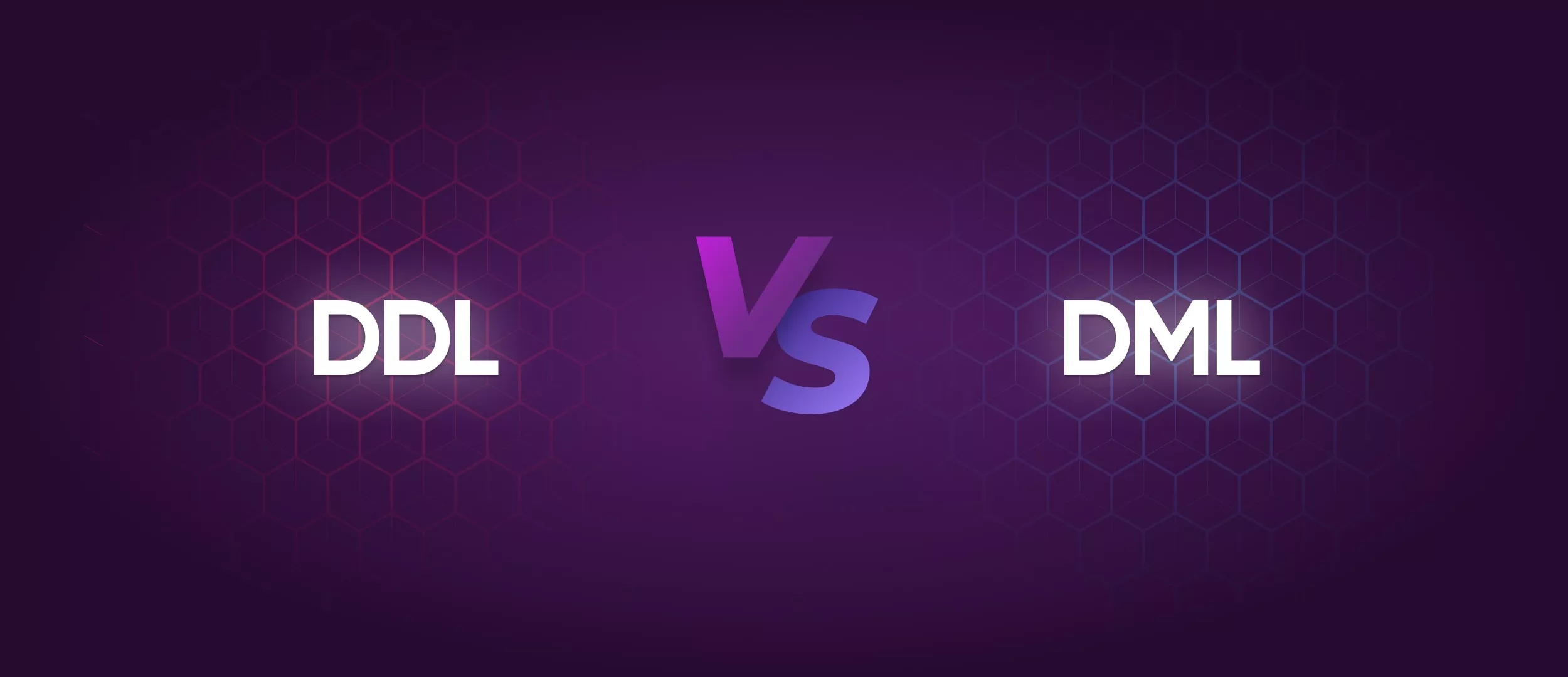
The key difference between DML and DDL is that DDL (Data Definition Language) is utilized to define the database schema. In contrast, DML (Data Manipulation Language) is used to manipulate the data within the database. In the blog post below, we will try to explain in detail the differences between DDL and DML.
What is DDL?
DDL stands for Data Definition Language, which is a subset of SQL (Structured Query Language) that is used to define and manipulate the structure of a database.
DDL commands are used to create, modify, and delete database objects such as tables, indexes, views, and procedures. These commands are used to define the data types and constraints that govern how data is stored and managed within a database.
Want a web app that does more?
Let's build a solution that's smart, sleek, and powerful.
Alina
Client Manager

Commands of DDL:
DDL (Data Definition Language) is a subset of SQL (Structured Query Language) that is used to create, modify, and delete database objects. Some of the most commonly used DDL commands are Create, Alter, Drop, Truncate, and Rename.
Create
The CREATE command is used to create new database objects, such as tables, indexes, views, and procedures. The syntax for the CREATE command varies depending on the type of object being created. For example, the syntax for creating a table would be:
CREATE TABLE table_name ( column1 datatype, column2 datatype, ... );
This command would create a new table with the specified column names and data types.
Alter
The ALTER command is used to modify the structure of an existing database object. This command can be used to add or remove columns from a table, modify the data type of a column, add or drop constraints, and more. The syntax for the ALTER command varies depending on the type of object being modified. For example, the syntax for adding a new column to an existing table would be:
ALTER TABLE table_name ADD column_name datatype;
This command would add a new column with the specified name and data type to the existing table.
Drop
The DROP command is used to delete an existing database object, such as a table, index, view, or procedure. When a database object is dropped, all data associated with the object is deleted as well. The syntax for the DROP command varies depending on the type of object being deleted. For example, the syntax for dropping a table would be:
DROP TABLE table_name;
This command would delete the specified table and all data associated with it.
Truncate
The TRUNCATE command is used to delete all data from an existing table. Unlike the DROP command, the TRUNCATE command does not delete the table itself, only the data within it. The syntax for the TRUNCATE command is:
TRUNCATE TABLE table_name;
This command would remove all data from the specified table.
Rename
The RENAME command is used to rename an existing database object, such as a table, index, view, or procedure. The syntax for the RENAME command varies depending on the type of object being renamed. For example, the syntax for renaming a table would be:
RENAME TABLE old_table_name TO new_table_name;
This command would rename the specified table from "old_table_name" to "new_table_name".
What is DML?
You may wonder, what is DML in SQL. So, DML stands for Data Manipulation Language, which is a subset of SQL (Structured Query Language) used to manipulate data stored in a database. Unlike DDL (Data Definition Language), which is used to define the structure of a database, DML is used to perform operations on the data itself, such as inserting, updating, and deleting records.
Commands of DML
DML (Data Manipulation Language) is a subset of SQL (Structured Query Language) that is used to manipulate data in a database. There are four primary types of SQL statements in DLM.
Select
The SELECT command is used to retrieve data from one or more tables in a database. It allows you to specify which columns to retrieve and apply filters to the data using conditions. The syntax for the SELECT command is:
SELECT column1, column2, ... FROM table_name WHERE condition;
This command would retrieve data from the specified table and columns, applying the specified condition to filter the results.
Insert
The INSERT command is used to add new records to a table in a database. It allows you to specify the values for each column in the new record. The syntax is:
INSERT INTO table_name (column1, column2, ...) VALUES (value1, value2, ...);
This command would add a new record to the specified table, with the specified column values.
Update
The UPDATE command is used to change existing records in a table. It allows you to change the values of one or more columns for one or more records based on a specified set of criteria. The syntax for the UPDATE command is:
UPDATE table_name SET column1 = value1, column2 = value2, ... WHERE condition;
This command would update the specified columns with the specified values, for the records that match the specified condition.
Delete
The DELETE command is used to remove records from a table in a database. It allows you to specify which records to remove based on a specified set of criteria. The syntax is:
DELETE FROM table_name WHERE condition;
This command would remove the records that match the specified condition from the specified table.
DML commands are essential for managing and manipulating data within a database. They are widely used by developers, data analysts, and database administrators to perform various data-related tasks, such as querying data, inserting new records, modifying existing records, and deleting records.
What is the difference between DDL and DML?
DDL (Data Definition Language) and DML (Data Manipulation Language) are two of the most important parts of SQL (Structured Query Language). Although both are used to interact with a database, they have distinct purposes and functions.
The key difference between DDL and DML is that DDL is used to create, modify, and delete database objects, while DML is used to manipulate data within those objects.
Differences between DDL and DML include:
- DDL is focused on defining the database schema, whereas DML is focused on modifying the data stored within the schema.
- DDL changes the structure of the database, while DML changes the contents of the database.
- DDL commands do not affect the data stored in a database, whereas DML commands do.
- In summary, DDL is used to define and modify the structure of a database, while DML is used to perform operations on the data stored within the database. Both are essential for managing and interacting with a database and understanding the differences between the two is crucial for effective database management.
Bottom Line
DDL (Data Definition Language) and DML (Data Manipulation Language) are two important subsets of SQL (Structured Query Language) that are used to interact with a database. The main difference between DDL and DML is their purpose:
- DDL is used to define, modify, and manage the structure of a database, including creating and modifying tables, views, indexes, and other database objects.
- DML is used to manipulate the data stored in a database, including adding, modifying, and deleting records in tables.
If you are interested in building a project, just contact us, and we will provide you with all the necessary information.



